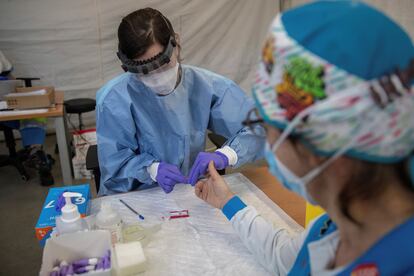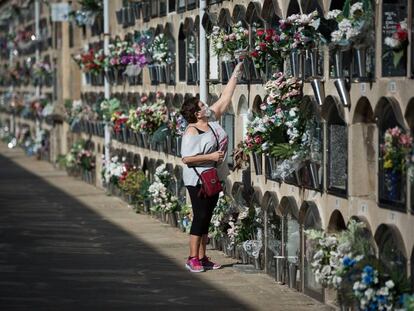Spain deescalating coronavirus measures without testing all suspected cases
According to Health Ministry reports, most of the country moved to Phase 1 even though the primary healthcare services could test less than half of possible Covid-19 patients

Most of Spain moved to Phase 1 of the coronavirus deescalation plan even though primary healthcare systems could only test less than half of all suspected Covid-19 cases via PCR lab tests. That’s according to reports from the Spanish Health Ministry, released on Monday following demands by regional governments for greater transparency, that set out the reasons for and against allowing regions to relax their confinement measures.
In the small northern region of La Rioja, the primary healthcare system was diagnosing up to 100% of all suspected coronavirus cases via PCR tests. But it was the exception. According to the reports, most of Spain’s 17 regions were able to diagnose far fewer patients. The figure was 50% in Madrid, 41% in the Basque Country, between 40% and 43% in Castilla-La Mancha, and 14.3% in Asturias.
Only the small northern region of La Rioja was testing 100% of suspected coronavirus cases
In Castilla y Léon, more than 80% of cases were diagnosed in five provinces, and in Andalusia the rate was 52.7%, although Málaga and Granada, which were held back in Phase 0 longer that the other Andalusian provinces, only reported 48% and 45.3% respectively. To move to the next phase, Granada increased its testing capacity to 50.5%, while in Málaga it fell to 32.8%. In Catalonia, Barcelona and its north and south metropolitan area was testing 21% of suspected coronavirus cases.
The disparity in testing capability reflects the differences in how the outbreak has hit each region. For example, a region that is not able to diagnose a large number of cases but has a very low incidence of coronavirus (such as Asturias) would be in a better position that a region that has a greater diagnostic capability, but a higher infection rate, such as Castilla y León.
The ability to quickly test suspected cases, isolate them, identify their contacts and cut the chain of transmission has always been a top priority by the Health Ministry in the path towards the “new normality.” The central government has tasked the primary healthcare system with detecting each new case, and together with regional public health services, tracing all their contacts to test whether they have also caught the virus.
But the reports published on Monday indicate that most areas of Spain were far from achieving this goal when they moved to Phase 1. Primary care facilities were unable to test a large number of suspected infections, while hospitals carried out PCR tests on 100% of cases.
Recommendations
The Health Ministry reports did not generally outline the shortcomings of a region, but rather suggested recommendations for improvements. For example, regional authorities in Extremadura were told: “The commitment to reach 100% from May 11 will require a significant organizational effort.” This region was only carrying out PCR tests on 26.2% of suspected cases in the province of Badajoz, and 19.1% in Cáceres.
In the case of Catalonia, the report warned that the north and south metropolitan areas of Barcelona (but not the city itself) needed to increase testing capacity, which was between 73% and 88%, “in case of a new outbreak.”
The Madrid region was told in a May 15 report that it would not be able to move to Phase 1 until the Health Ministry saw that it had strengthened the diagnostic capacity, early detection system and tracing of contacts in primary healthcare facilities. Last week, regional authorities explained that they had increased the number of staff monitoring the outbreak from 36 to 169, according to a May 22 report. The region also highlighted that it had a system to trace the contacts of coronavirus patients, which would be carried out with “the support of technology and multidisciplinary teams.” Last Friday, the central government allowed Madrid to transition to Phase 1 after twice rejecting its request.
On May 11, 14 of Valencia’s 24 healthcare regions were refused permission to move to Phase 1, a decision that was challenged by the regional government which accused the Health Ministry of lack of transparency. In the report to justify its decision, the Health Ministry called for more PCR testing (between 80% and 100% of all suspected cases) and warned that some areas still had infection rates above or equal to 50 cases per 100,000 inhabitants.
English version by Melissa Kitson.
Tu suscripción se está usando en otro dispositivo
¿Quieres añadir otro usuario a tu suscripción?
Si continúas leyendo en este dispositivo, no se podrá leer en el otro.
FlechaTu suscripción se está usando en otro dispositivo y solo puedes acceder a EL PAÍS desde un dispositivo a la vez.
Si quieres compartir tu cuenta, cambia tu suscripción a la modalidad Premium, así podrás añadir otro usuario. Cada uno accederá con su propia cuenta de email, lo que os permitirá personalizar vuestra experiencia en EL PAÍS.
¿Tienes una suscripción de empresa? Accede aquí para contratar más cuentas.
En el caso de no saber quién está usando tu cuenta, te recomendamos cambiar tu contraseña aquí.
Si decides continuar compartiendo tu cuenta, este mensaje se mostrará en tu dispositivo y en el de la otra persona que está usando tu cuenta de forma indefinida, afectando a tu experiencia de lectura. Puedes consultar aquí los términos y condiciones de la suscripción digital.
More information
Últimas noticias
From Andorra to Gibraltar, a black market for Ozempic exploits its success: ‘They’re the most sought-after products in the world’
Magnets in their heads: How some animals guide themselves using the Earth’s magnetic field
From Hungary’s Orbán to Chile’s Kast: How Trump helps turbo charge the far right
The brief rise and retreat of Generation Z in Mexico
Most viewed
- Why we lost the habit of sleeping in two segments and how that changed our sense of time
- Trump’s obsession with putting his name on everything is unprecedented in the United States
- Charles Dubouloz, mountaineering star, retires at 36 with a farewell tour inspired by Walter Bonatti
- Venezuela faces its most tense Christmas yet
- The Florida Keys tourist paradise is besieged by immigration agents: ‘We’ve never seen anything like this’










































